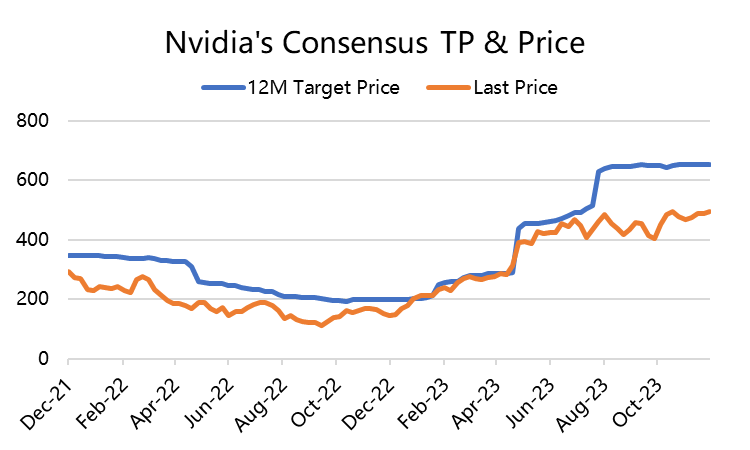Big-Tech’s Performance
In the final week of 2023, with the arrival of the Christmas and New Year holidays, market fluctuations were not significant. Major stock indices remained stable and closed at relatively high levels. However, the US dollar continued to experience a significant pullback, and related exchange rate changes would impact international investors' returns and the performance of multinational corporations.
The largest increase is in $NVIDIA Corp(NVDA)$ +2.93%, followed by $Meta Platforms, Inc.(META)$ +2.59%, $Tesla Motors(TSLA)$ +2.44%, $Alphabet(GOOG)$ +1.37%, $Microsoft(MSFT)$ +1.26%, $Amazon.com(AMZN)$ +0.83%, and $Apple(AAPL)$ alone dropped -0.64%.
Big-Tech’s Top Newsfeed
Apple resumed sales of its Watch products in retail stores on December 27.
Ming-Chi Kuo believes that Apple's spring event in March next year is not expected to bring significant updates in AI services.
The New York Times sued OpenAI and Microsoft, claiming that their copyrights for written works were violated.
Amazon won a lawsuit in the European Union's highest court regarding a 250 million euro tax case.
NVIDIA released the RTX 4090 D graphics card with a starting price of 12,999 yuan.
It was reported that NVIDIA made substantial advance payments to SK Hynix and Micron to ensure HBM supply.
Meta will showcase a prototype of advanced AR glasses next year, claiming it to be the "most advanced consumer electronic device."
Elon Musk debunked the "Tesla robot attacks engineer" rumor, related to an incident with a KUKA robotic arm two years ago.
Big-Tech’s Key insights
Major tech companies have been the main contributors to the significant index gains in 2023. However, with the consistent "shift" into the 2024 interest rate reduction cycle, will major tech companies still have a bright future?
NVIDIA
Bloomberg's consensus forecast: Revenue for 2024 is expected to be $92.37 billion, a year-on-year increase of 56%; EBIT profit of $57.8 billion, a year-on-year increase of 64%, with a profit margin of 54%, which is an excellent level.
The target price expectation is $652, representing a 32 % premium over the current price of $495.22.
The breakthrough in AI has sparked a sudden surge in the chip industry, which was previously experiencing a decline in demand. Despite NVIDIA's impressive return of 238% in 2023, surpassing the $500 mark, the target average price from investment banks still exceeds $650.
The rapid growth of the data center business driven by artificial intelligence has helped the company achieve higher revenue and profit margins, thereby leading to stronger cash flow. This trend is expected to continue in 2024, with its revenue growth forecast remaining the fastest among all leading tech companies.
The market was previously concerned about the impact of the ban on Chinese chips. NVIDIA is exploring the use of compliant alternative chips to replace them and is also increasing its market share in other areas to compensate for any shortfall. However, this impact has already been more or less reflected in its valuation and pricing.
Although many investors are wary of its current high P/E ratio, considering its profit growth rate, it is not exaggerated from a PEG perspective. The current P/E ratio for the past 12 months is 63 times, corresponding to 40 times in 2024, and an estimated 24 times in 2025, which is not much higher than the industry average.
Tesla
Bloomberg's consensus expectations: The revenue for 2024 is projected to be $118 billion, with a year-on-year increase of 21%; EBIT profit is expected to be $13.15 billion, with a year-on-year increase of 39%, and the profit margin is expected to rise to 11%, higher than this year's level.
The target price expectation is $242, while the individual forecast is $257. The market is not optimistic about its stock price for 2024.
Tesla's stock price behaves independently, with the lowest correlation to the S&P 500 index among all "Seven Giants," but its volatility is significant, making it a favorite target for options traders.
The company's fundamentals almost determine the industry's fundamentals. With increasing production capacity and the growth of new competitors, the market supply and demand for new energy vehicles have reversed, leading to frequent price wars, while breakthroughs in new technology are not easy. With multiple price adjustments, Tesla's gross margin has dropped from over 25% in 2022 to less than 18% in the most recent quarter. If raw material prices continue to move against the company, further reductions are possible, which is an important reason for the continuously declining market expectations.
Of course, the comprehensive implementation of FSD and the commercial prospects of Dojo supercomputers may still take time. Before that, under the strong leadership of Musk with a strong focus on topical issues, Tesla may still need to achieve higher profit margins through cost control.
The Big-Tech Portfolio
We combine the seven companies with the highest weights into an investment portfolio, called the "Tanmam" portfolio.
By backtesting this portfolio using equal weights and adjusting the weights quarterly since 2015, the performance has far exceeded the S&P 500, with a total return of 1492%, continuing to hover at high levels. During the same period, the $SPDR S&P 500 ETF Trust(SPY)$ had a return of 172.8%, also approaching a new high.
The year-to-date return is 110.4%, higher than SPY's 26.6%. The Sharpe ratio is 4.6, while SPY's is 1.3 during the same period.
The return of the portfolio this week is 0.2%, while SPY's return is 0.8%.


Comments